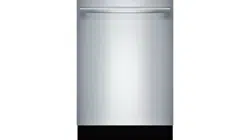Documents: Go to download!
- Owner's manual - (English, French)
USER MANUAL Dishwasher
Getting Started
Appliance overview
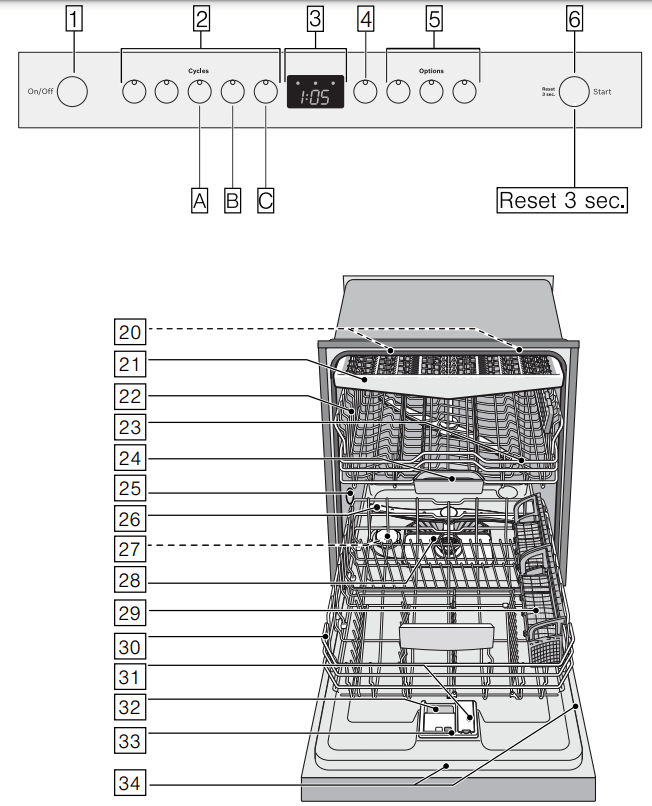
Operating panel
- On/Off button
- Wash cycles
- Digital display
- Delay start button
- Wash cycle options
- Start button
Dishwasher interior components
20. Interior light *
21. Third rack
22. Upper rack
23. Upper spray arm
24. Detergent tab tray
25. Vent hole
26. Lower spray arm
27. Dispenser for special salt*
28. Filters
29. Silverware basket
30. Lower rack
31. Rinse aid dispenser
32. Detergent dispenser
33. Lock for detergent dispenser
34. Rating plate
Display indicators
 | Cycle time remaining |
| Clean | Lights up when dishes are clean |
| Sanitize | Lights up when sanitation requirements are met |
| Add Rinse Aid | Lights up when rinse aid is low |
Menu overview

Loading the Dishwasher
Loading the racks
For best dishwashing results, observe the following when loading the dishwasher:
■ Do not pre-wash items with loosely attached food soil.
■ Remove all food particles, bones, toothpicks and excessive grease.
■ Pre-treat items having burned-on, baked-on or starchy soils.
■ Load dishes in the dishwasher racks so the insides of bowls, pots and pans are facing the spray arms.
■ Avoid nesting and contact points between dishes.
■ Separate items of dissimilar metals. Use care to not block movement of the spray arms.
■ Only wash household dishware and kitchenware rated as dishwasher-safe. Refer to the Dishware Materials section for more information about dishware suitability.
Loading the upper rack
Ensure items do not protrude through the bottom of the racks and block the spray arms.
Note: When pushing the upper rack 22 into the dishwasher, push it until it stops against the back of the tub so the upper rack spray arm 23 connects to the water supply at the back of the tub. Do not push racks in using the door.
Loading the lower rack
Place large items in the lower rack 30. Load pots, pans and bowls upside down. Do not block the vent hole 25 with tall baking sheets. Load these items on the right side of the dishwasher.
Loading the silverware basket
Place knives and sharp utensils with their handles up and forks and spoons with their handles down. If large or oddly-shaped items are loaded in the silverware basket, be sure they do not nest together.
Long silverware basket

This dishwasher is equipped with a silverware drawer that should accommodate most silverware loading needs.
However, if you are washing while the silverware drawer has been removed, or with excess silverware, a silverware basket is also included.
When loading the silverware basket you should avoid excessive contact points and nesting of similar items (allowing two spons to rest inside one another).
A good way to avoid excessive contact points is to load the silverware basket with the lids closed, inserting each piece of silverware into one of the individual slots as shown.
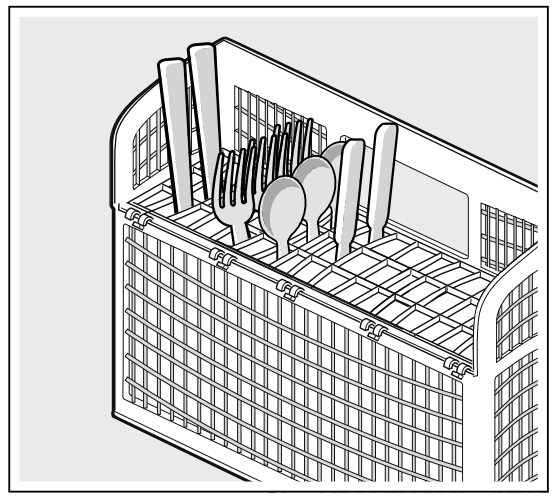
Care and Maintenance
Overall condition of the dishwasher
NOTICE
■ Never use a steam cleaner to clean your dishwasher. The manufacturer is not liable for any resulting damage.
■ Regularly wipe the front of the appliance with a damp cloth - water and a small amount of liquid soap is adequate. Do not use sponges as they could scratch the surfaces.
■ Do not use bleach-based wipes as they could damage the surface or printing.
■ Stainless steel appliances: To prevent corrosion, do not use sponges or chlorine based cleaners. Use a stainless steel polish to seal and protect the surface. Do not use chlorine based cleaners or wipes.
■ Clean the outer edges of the inside door panel regularly to remove debris that may collect from normal loading. If spots begin to appear on the stainless steel, make sure the rinse agent is full and functioning properly.
■ Clean the door seal regularly with a damp cloth to remove food particles that may collect from normal loading and cause odor. A soiled door seal may not seal properly.
Filters
The Bosch® filter system 28 is designed to prevent the need to pre-rinse normally attached food soils from your dishes. Simply scrape leftover food soils off of dishware before loading. This process will conserve time, water and the energy require to heat your household water supply.
Your dishwasher filter system is designed to filter 100% of the water entering the spray arms to provide a continuous supply of clean water to remove food soils from your dishware.
Filter components
The filter system 28 consists of three parts
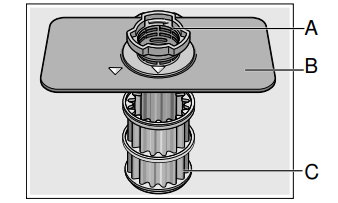
A. Large Object Trap
Prevents objects that should not be placed in your dishwasher from damaging the dishwasher pump system or clogging your household drain.
B. Flat Fine Filter
Prevents food particles from entering the wash chamber and directs particles toward the micro filter.
C. Micro Filter
Directs the smallest of particles to the household plumbing drain.
Cleaning intervals
The filter system 28 is designed to minimize maintenance while providing premium cleaning performance and minimum energy consumption.
Depending on use habits and water hardness, the filter system will require some maintenance to sustain premium cleaning performance. Your filter system may need to be cleaned when:
■ You notice food soils remaining on the filter system or objects trapped in the Large Object Trap.
■ A drop in cleaning performance or a gritty film forms on the dishware.
When washing normally attached food soils that have been scraped before loading, in a household that runs the dishwasher every other day, your filter should be cleaned:
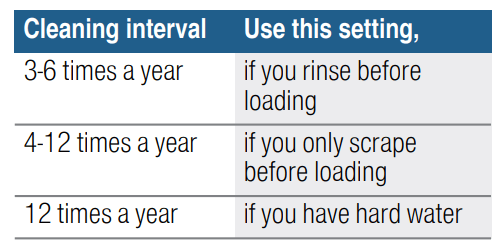
To check or clean the filter system:
1. Unscrew the Large Object Trap as illustrated and remove the entire filter system.
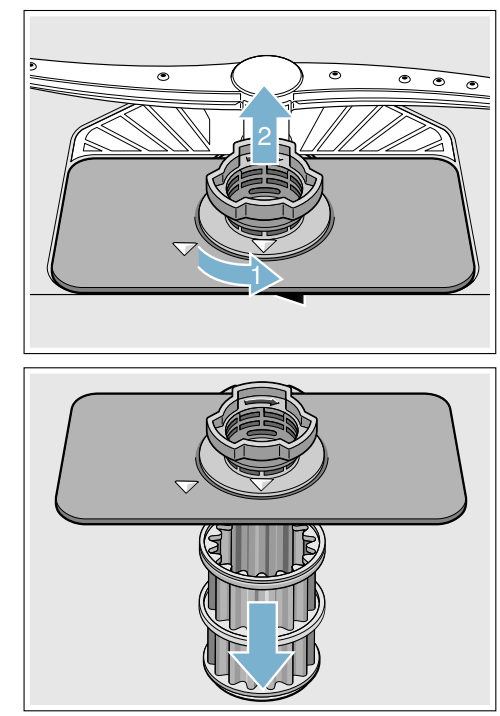
2. Remove any residue and clean filters by rinsing under running water. Note: do not use abrasive brushes or steel wool, etc., as they may damage the filter.
3. Reinstall the filter system in reverse sequence and lock into place by screwing the Large Object Trap until the marking arrows align.
Spray arms
Check spray arms 23, 26 for grease and limescale deposits. If you find such deposits:
■ Fill detergent dispenser 32 with detergent and start the appliance without utensils in the cycle with the highest rinsing temperature. ~ "Wash Cycle Information" on page 24
■ Clean the appliance with detergents/appliance cleaners which are particularly suitable for use with dishwashers.
■ Unscrew the upper spray arm 23 and pull off the lower spray 26 arm as shown. Inspect for deposits.

Drain pump
Large food remnants in the rinsing water not retained by the filters may block the waste water pump. In this case:
■ Disconnect the appliance from the power supply.
■ Remove the filters. ~ "Filters" on page 30
■ Scoop out standing water - use a sponge if necessary.
■ Using a spoon, pry off the pump cover until it clicks, then grip the cover and pull upward until it resists and then pull forward.
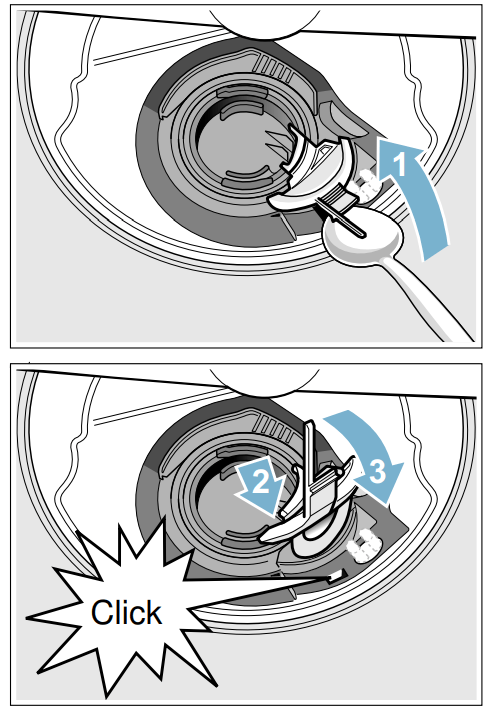
■ Check inner compartment and remove any foreign objects.
■ Place cover in the original position, press down and engage.
■ Reinstall filters.
Preparing your unit for vacation
NOTICE
Before leaving for vacation during warmer weather, besides turning off the main valve, also turn off water supply at the nearest point to the dishwasher. Do not leave soiled dishware in unit and leave door slightly open. During colder weather, please follow the instructions for winterizing your unit below.
Winterizing your unit
NOTICE
If your dishwasher will be unused for a period of time in a location that experiences freezing temperatures (holiday home or through a vacation period), have your dishwasher winterized by a professional service.
Troubleshooting
| Problem | Cause | Action |
| Dishwasher does not start | Door may not be properly latched. | Shut the door completely until you hear a click. |
| Dishwasher may not be turned on. | Press the main power switch 1 to turn dishwasher on. | |
| Dishwasher not reset or previous cycle not completed. | Reset the dishwasher. | |
| Delay start engaged. | Reset Delay start. ~ "Delay Start" on page 27 | |
| Interruption of electrical power supply to dishwasher or blown fuse. | Check circuit breaker | |
| The door may have been closed without first selecting a cycle. | Select a cycle and close the door. | |
| Water supply may not be turned on. | Check and turn on water supply. | |
| Cycle does not resume after door is opened and closed during cycle. | Door is opened longer than 4 seconds after a cycle has started. | Press Start button again to resume cycle. |
| Display does not illuminate | A fuse may have been blown or circuit breaker tripped. | Check the fuse or circuit breaker box and replace the fuse or reset the breaker if necessary. |
Door not closed or latched. Note: For models with controls on top of the door, the display only illuminates when the door is opened and controls are visible. | Ensure door is properly latched and completely closed. | |
| Dishwasher seems to run a long time | Incoming water is not warm enough. | Before starting a cycle, run hot water faucet at the sink closest to the dishwasher. |
| Cycle time can vary due to soil and water conditions. | Sensors in the dishwasher automatically increase the cycle time to ensure a good wash when heavy soil is detected. | |
| Rinse aid dispenser 31 is empty, or rinse aid setting has been set to “0”. | Add rinse aid, or change rinse aid setting. | |
Dishwasher connected to cold water supply. Note: Check the typical wash cycle length. ~ "Wash Cycle Information" on page 24 | Verify dishwasher is connected to hot water supply plumbing. | |
| Dishes are not getting clean enough | Spray arm movement obstructed. | Ensure that spray arm movement is not blocked by hand rotating spray arms 23, 26 before starting cycle |
| Spray arm nozzles clogged. | Remove spray arms 23, 26 and clean them. ~ "Spray arms" on page 31 | |
| Improper use of detergents. | Increase or decrease detergent depending on the water hardness. | |
| Filters 28 could be clogged. | Clean the filters 28. ~ "Filter components" on page 30 | |
| Dishes are nested or loaded too closely together. | Rearrange load such that water spray can reach all items in the dishwasher. ~ "Loading the Dishwasher" on page 13 | |
| Selected wash cycle is not suitable for food soil conditions. | Refer to Wash Cycle Information. ~ "Wash Cycle Information" on page 24 | |
| Streaks on glassware or residue on the dishes | Incorrect rinse aid setting. | Depending on the hardness of water, adjust the rinse agent dispenser 31. ~ "Rinse Aid" on page 12 |
Dishes are not getting dry enough Note: Plastic or Teflon do not typically dry as well as other items due to their inherent properties. | Rinse aid dispenser 31 is empty or incorrect rinse aid amount is set. | Add rinse aid or adjust setting - the use of rinse agent improves drying, use the Auto cycle, use the Sanitize option. |
| Improper loading of dishes. | Rearrange load to ensure items are not nesting. ~ "Loading the Dishwasher" on page 13 Note: Select models offer an extra heating option to improve drying performance. | |
Odor Note: Water testing is done in the factory. Occasionally water may still appear in dishwasher at purchase which may create an odor. | Food debris is present at the bottom of the dishwasher. | Remove the filters and clean them. ~ "Care and Maintenance" on page 29 |
| Food particles are present near the door seal. | ~ "Care and Maintenance" on page 29 | |
| Residual water is present at the bottom of the dishwasher. | Ensure the dishwasher has completely drained from the last cycle. | |
| Drain hose is obstructed. | Remove any obstructions from the drain hose by calling qualified personnel. Note: If odor still persists, run the Normal/ Regular cycle until it flushes and interrupt the cycle and place an 8 oz. cup of distilled white vinegar solution on the upper rack and then finish the cycle. | |
| Dishwasher not filling with water or “Check water supply” display lights up | Restriction in the water supply system. | Ensure that the water supply valve (typically located under kitchen sink) is open and check that the water supply line has no kinks or clogs. |
| revious wash cycle was not completed. | ~ "Operating the Dishwasher" on page 26 | |
| Delay start is active. | Cancel the delay start or wait until delay start time completes. | |
| Household water supply turned off. | Turn on water supply. | |
| Fascia panel discolored or marked | Abrasive cleaner used. | Use mild detergents with soft damp cloth. |
| Noise during wash cycle | Dishes may not be arranged properly. | Water circulation sound is normal, but if you suspect items are banging into each other or into the spray arms, check optimal arrangement of dishes. ~ "Loading the Dishwasher" on page 13 |
| Water leaks | Suds. | Using wrong type of detergent or overfilling the rinse aid dispenser results in suds and leaks - use only dishwasher detergents. If suds still persist, add one tablespoon of vegetable oil at the bottom of the dishwasher and run the desired cycle. |
| Door seal could be pulled away from track. | Ensure the door seal is in the track. | |
| Condensation vent is blocked. | Ensure that condensation vent is not blocked. | |
| Improper installation. | Have proper installation verified by qualified personnel (water supply, drain system, leveling, plumbing). | |
| Tub stains | Stains on the dishwasher interior are due to water hardness. | Concentrated lemon juice can reduce the build-up of hard water stains. Run Normal/Regular cycle until it flushes and interrupt the cycle and then place an 8 oz. cup of the concentrated lemon solution on the upper rack and finish the cycle. This can be done periodically to avoid build-up. |
| Silverware in contact with tub. | Ensure that silverware does not make contact with the tub while running a cycle. | |
| Detergent dispenser cover will not shut | Improper operation of detergent cover. | For instructions on opening and closing the dispenser ~ "Detergent" on page 21 |
| Previous cycle was not finished or interrupted. | ~ "Operating the Dishwasher" on page 26 | |
| Unable to select desired cycle | Previous cycle not finished. | ~ "Operating the Dishwasher" on page 26 |
See other models: DPH30652UC SHS63VL5UC SHSM63W55N HBLP651LUC, B21CT80SNB
